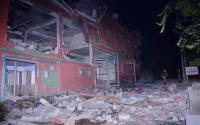WASHINGTON - Thirty years ago, they stormed the New Hampshire coast, arriving by foot and by boat, to be met by state police, National Guard troops and a governor roaming the site in army fatigues.
By the time they slapped the cuffs on Paul Gunter and more than 1,400 others known collectively as the Clamshell Alliance, the battle had already been won and a band of New England activists had stalled the Seabrook nuclear plant and essentially stopped the American nuclear industry. 
The 1979 near meltdown at Three Mile Island in Pennsylvania is remembered as the breaking point for the nuclear industry in this country, but Clamshell and the dozen of anti-nuke movements it spawned had already turned public opinion against the industry and is credited with killing Washington’s plans to build hundreds of new nuclear stations during the late 1970s and beyond.
Three decades later, they are girding for renewed battle.
They fear they are standing on the brink of a nuclear renaissance, the hum of the reactors building again, this time in the name of fighting global warming.
And that’s the nub of the fight in this country, where many who have faithfully stood guard against the nuclear industry are also in the vanguard of the fight to combat global warming.
“We run the risk of trading global warming for nuclear winter,” says Gunter, the 58-year-director of the Reactor Watchdog Project at the Nuclear Information and Resource Service.
Gunter says he has been trying to drive a stake through the heart of the nuclear industry since 1975.
“Here we go again,” he says.
The momentum toward nuclear got another bump last week when the United Nation’s Intergovernmental Panel on Climate Change said nuclear power, which accounted for 16 per cent of the world’s electricity supply in 2005, could increase to 18 per cent by 2030.
That won applause from the Bush administration, which is pushing nuclear expansion.
“It is now well understood by policymakers that if you intend to be serious about climate change and reducing greenhouse gases, you have to be serious about a significant expansion of the world’s use of zero-emission nuclear energy,” said Jim Connaughton, director of the White House Council on Environmental Quality.
“Those that do have the capacity to use the energy have an obligation to do so if we want to take a nice dent out of the growth of greenhouse gases.”
Nuclear power can reduce greenhouse gas emissions, but the UN panel pointed to three challenges the industry must overcome - safety, weapons proliferation and waste.
It could have added a fourth - cost.
And a fifth - the fear that nuclear generators are targets for terrorists.
But the American nuclear industry is making headway in tackling its image problem and allaying fears that date back to the Three Mile Island partial meltdown of 1979 and the Chernobyl disaster in Russia of 1986.
Some 15 companies and consortia have recently announced plans to file construction and operating licence applications with U.S. regulators for up to 34 new plants.
There are now 103 commercial reactors in 31 states, slaking about 20 per cent of the American energy thirst. But to meet increasing demand, the U.S. Department of Energy has estimated there could be 50 new reactors on stream by 2030.
The last new nuclear licence was granted in 1973 - six years before Three Mile Island - and the last plant to come on line was Watts Bar in Tennessee in 1996 - 22 years after construction was started. But plant number 104, the first of the 21st century, is set to fire up any day in Athens, Ala., where the Browns Ferry plant, mothballed since 1985, has been restored.
Trish Conrad of the Nuclear Energy Institute acknowledges challenges for the industry.
She says Chernobyl would never have never been built on this continent and Three Mile Island had no lasting health impact on anyone.
“But psychologically, that had an impact on how people view nuclear power,” she says.
The industry, however, brags a stellar safety record since then and in 2006 boasted that 97 per cent of its key safety systems operated as planned.
About 100 nuclear plants were cancelled in the 1970s as activists battled the nuclear vision of president Richard Nixon. Now they see the cycle has come full circle under George W. Bush.
The 2005 energy bill passed by the Republican-led Congress provided a $125 million (U.S.) tax credit each year for every 1,000 megawatts of generation constructed and the industry would be able to recoup construction cost overruns if they are linked to delays in the regulatory process.
Existing reactors produce about 20 tonnes of waste each year, stored in special pools on the reactor sites because plans for an underground repository in Nevada’s Yucca Mountains remained stalled by environmental concerns.
The most powerful man in the U.S. Senate, Majority leader Harry Reid, also happens to be Nevada’s senior senator and he has flatly stated the Yucca dump site will never be opened.
Connaughton says the U.S. is actively working to properly recycle spent nuclear fuel, and with the political will, the remainder can be safely stored with “a tiny, tiny, tiny, tiny geographic footprint.”
Former U.S. vice-president Al Gore has said he sees nuclear plants as a “small part” of the global warming strategy, but warned that they are so expensive, take so long to build and “only come in one size, extra large,” that it can be only a small component of the battle plan.
Patrick Moore, who helped found Greenpeace, says he once equated nuclear energy with nuclear holocaust, but is now a proponent of the nuclear alternative, calling on the environmental movement to update its thinking.
Gunter didn’t get the memo.
“There are so many `beware’ signs about venturing back into this quagmire. None of the questions which were on the table 30 years ago have been answered and concerns have merely been amplified,” he says.
“Let me clearly, for the record, say that rapid climate change is one of the most pressing issues to any environmentalist in the world today.
“That said, to venture into a relapse of nuclear power will squander our chances of mitigating this oncoming crisis.”
Conrad says her institute is not trying to exploit a split in the environmental movement, “but we accept the positive where we find it.”
Some noted experts on climate change, such as Art Rosenfeld, the commissioner of the California Energy Commission, remain on the fence. Rosenfeld said nuclear energy is an option for the future, but he didn’t see why the continent would move in that direction right now if “we are too dumb to stop buying incandescent bulbs.”
Phil Clapp, president of the National Environmental Trust, says it is a misconception that it was environmental regulation which sounded the death knoll for the first generation of nuclear power plants.
Economics brought the house down, he says.
Some utilities saw nuclear costs soar as much as 1,600 per cent over budget, Clapp says, companies went bankrupt and Wall Street threatened to turn their bond ratings to junk.
That continues today, he says, with American utilities still carrying $80 billion (U.S.) in debt from that ill-fated period.
© Copyright Toronto Star online since 1996






